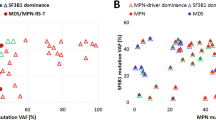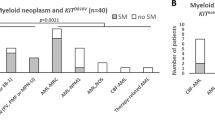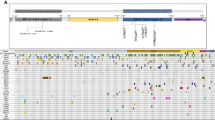Abstract
Truncation mutations of the receptor cytoplasmic domain for colony-stimulating factor 3 (CSF3R) are frequently seen in severe congenital neutropenia, whereas activating missense mutations affecting the extracellular domain (exon 14) have been described in hereditary neutrophilia and chronic neutrophilic leukemia (CNL). In order to clarify mutational frequency, specificity and phenotypic associations, we sequenced CSF3R exons 14–17 in 54 clinically suspected cases of CNL (n=35) or atypical chronic myeloid leukemia (aCML; n=19). Central review of these cases confirmed WHO-defined CNL in 12 patients, monoclonal gammopathy (MG)-associated CNL in 5 and WHO-defined aCML in 9. A total of 14 CSF3R mutations were detected in 13 patients, including 10 with CSF3RT618I (exon 14 mutation, sometimes annotated as CSF3R T595I). CSF3RT618I occurred exclusively in WHO-defined CNL with a mutational frequency of 83% (10 of 12 cases). CSF3R mutations were not seen in aCML or MG-associated CNL. CSF3RT618I was also absent among 170 patients with primary myelofibrosis (PMF; n=76) or chronic myelomonocytic leukemia (CMML; n=94). SETBP1 mutational frequencies in WHO-defined CNL, aCML, CMML and PMF were 33, 0, 7 and 3%, respectively. Four CSF3RT618I-mutated cases co-expressed SETBP1 mutations. We conclude that CSF3RT618I is a highly sensitive and specific molecular marker for CNL and should be incorporated into current diagnostic criteria.
This is a preview of subscription content, access via your institution
Access options
Subscribe to this journal
Receive 12 print issues and online access
$259.00 per year
only $21.58 per issue
Buy this article
- Purchase on Springer Link
- Instant access to full article PDF
Prices may be subject to local taxes which are calculated during checkout



Similar content being viewed by others
References
Metcalf D . The granulocyte-macrophage colony-stimulating factors. Science 1985; 229: 16–22.
Dong F, van Buitenen C, Pouwels K, Hoefsloot LH, Lowenberg B, Touw IP . Distinct cytoplasmic regions of the human granulocyte colony-stimulating factor receptor involved in induction of proliferation and maturation. Mol Cell Biol 1993; 13: 7774–7781.
Germeshausen M, Welte K, Ballmaier M . In vivo expansion of cells expressing acquired CSF3R mutations in patients with severe congenital neutropenia. Blood 2009; 113: 668–670.
Germeshausen M, Ballmaier M, Welte K . Incidence of CSF3R mutations in severe congenital neutropenia and relevance for leukemogenesis: results of a long-term survey. Blood 2007; 109: 93–99.
Beekman R, Valkhof MG, Sanders MA, van Strien PM, Haanstra JR, Broeders L et al. Sequential gain of mutations in severe congenital neutropenia progressing to acute myeloid leukemia. Blood 2012; 119: 5071–5077.
Liu F, Kunter G, Krem MM, Eades WC, Cain JA, Tomasson MH et al. Csf3r mutations in mice confer a strong clonal HSC advantage via activation of Stat5. J Clin Invest 2008; 118: 946–955.
Kunter G, Woloszynek JR, Link DC . A truncation mutant of Csf3r cooperates with PML-RARalpha to induce acute myeloid leukemia in mice. Exp Hematol 2011; 39: 1136–1143.
Beekman R, Valkhof M, van Strien P, Valk P, Touw IP . Prevalence of a new auto-activating colony stimulating factor 3 receptor mutation (CSF3R-T595I) in acute myeloid leukemia and severe congenital neutropenia. Haematologica 2013; 98: e62–e63.
Plo I, Zhang Y, Le Couedic JP, Nakatake M, Boulet JM, Itaya M et al. An activating mutation in the CSF3R gene induces a hereditary chronic neutrophilia. J Exp Med 2009; 206: 1701–1707.
Forbes LV, Gale RE, Pizzey A, Pouwels K, Nathwani A, Linch DC . An activating mutation in the transmembrane domain of the granulocyte colony-stimulating factor receptor in patients with acute myeloid leukemia. Oncogene 2002; 21: 5981–5989.
Maxson JE, Gotlib J, Pollyea DA, Fleischman AG, Agareval A, Eide CA et al. Oncogenic CSF3R mutations in chronic neutrophilic leukemia and atypical CML. N Engl J Med 2013; 368: 1781–1790.
Vardiman J, Hyjek E . World Health Organization classification, evaluation, and genetics of the myeloproliferative neoplasm variants. Hematology Am Soc Hematol Educ Program 2011; 2011: 250–256.
Patnaik MM, Padron E, Laborde RR, Lasho TL, Finke CM, Hanson CA et al. Mayo prognostic model for WHO-defined chronic myelomonocytic leukemia: ASXL1 and spliceosome component mutations and outcomes. Leukemia, (e-pub ahead of print 27 March 2013; doi:10.1038/leu.2013.88).
Laborde RR, Patnaik MM, Lasho TL, Finke CM, Hanson CA, Knudson RA et al. SETBP1 mutations in 415 patients with primary myelofibrosis or chronic myelomonocytic leukemia (CMML): independent prognostic impact in CMML. Leukemia 2013.
Elliott MA, Hanson CA, Dewald GW, Smoley SA, Lasho TL, Tefferi A . WHO-defined chronic neutrophilic leukemia: a long-term analysis of 12 cases and a critical review of the literature. Leukemia 2005; 19: 313–317.
Piazza R, Valletta S, Winkelmann N, Redaelli S, Spinelli R, Pirola A et al. Recurrent SETBP1 mutations in atypical chronic myeloid leukemia. Nat Genet 2013; 45: 18–24.
Pardanani A, Laborde RR, Lasho TL, Finke C, Begna K, Al-Kali A et al. Safety and efficacy of CYT387, a JAK1 and JAK2 inhibitor, in myelofibrosis. Leukemia, (e-pub ahead of print 5 March 2013; doi:10.1038/leu.2013.71).
Purandare AV, McDevitt TM, Wan H, You D, Penhallow B, Han X et al. Characterization of BMS-911543, a functionally selective small-molecule inhibitor of JAK2. Leukemia 2012; 26: 280–288.
Author information
Authors and Affiliations
Corresponding author
Ethics declarations
Competing interests
The authors declare no conflict of interest.
Additional information
Author contributions
A Pardanani and A Tefferi designed the study, contributed patient samples, analyzed the data, and wrote the paper. J Tyner contributed to data analysis and writing of the paper. MA Elliott contributed patient samples. CA Hanson reviewed bone marrow histology. RA Knudson and RP Ketterling reviewed the cytogenetics data. TL Lasho and R Laborde performed the molecular studies.
Rights and permissions
About this article
Cite this article
Pardanani, A., Lasho, T., Laborde, R. et al. CSF3R T618I is a highly prevalent and specific mutation in chronic neutrophilic leukemia. Leukemia 27, 1870–1873 (2013). https://doi.org/10.1038/leu.2013.122
Received:
Accepted:
Published:
Issue Date:
DOI: https://doi.org/10.1038/leu.2013.122
Keywords
This article is cited by
-
WHO-Klassifikation 2022 chronischer myeloproliferativer Erkrankungen
Die Onkologie (2023)
-
A case of plasma cell neoplasm-associated chronic neutrophilic leukemia with ASXL1 and JAK2V617F mutations
Annals of Hematology (2022)
-
The 5th edition of the World Health Organization Classification of Haematolymphoid Tumours: Myeloid and Histiocytic/Dendritic Neoplasms
Leukemia (2022)
-
Outgrowth of a CSF3R-mutant clone drives a second myeloproliferative neoplasm in a chronic myeloid leukemia patient: a case report
Biomarker Research (2021)
-
CSF3R T618I mutant chronic myelomonocytic leukemia (CMML) defines a proliferative CMML subtype enriched in ASXL1 mutations with adverse outcomes
Blood Cancer Journal (2021)



